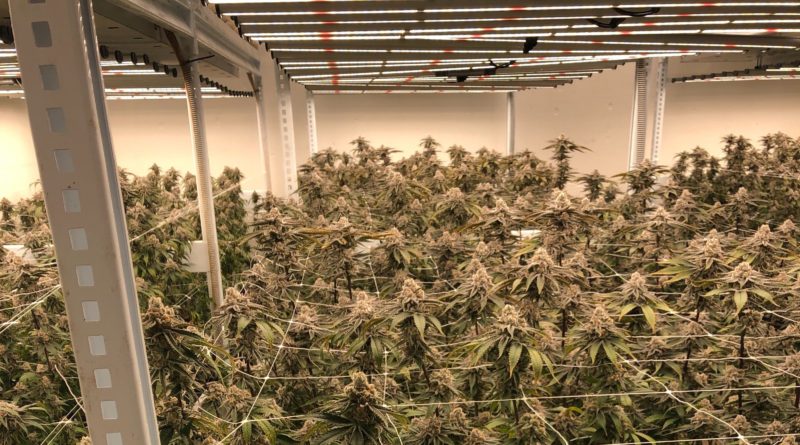
Going Vertical
Indoor vertical growing has been a hot topic, in both the cannabis and leafy greens industries, over the past several years. As the cannabis industry continues to grow at a substantial rate, the equipment behind the growing is as well. Successful growers have turned to a combination of a racking system, grow light solution, environmental controls and a clean production schedule to help alleviate the worries of breaking into the cannabis world.
RACKING SYSTEMS
Benching becomes unique once a grower decides to scale up. Many factors need to be considered: Irrigation pressure and drainage need to be planned out to not allow flooding of the tables below, electrical needs to be carefully protected, and lastly the rack needs to hold hundreds of pounds.
There are a couple companies that have moved into this sector and they all took the 4×8-foot standardized palletizing racking system and modified it to hold plants by adding flood tables. Not all tables are created equal, though. Some have fancy troughs that can pull out; others are your typical flood table made of aluminum or plastic. Most of these features are luxurious but can come in handy as long as it is watertight. The pullout troughs can be extremely useful for a laborer not having to put their body into the plant canopy if there is not a trellis system already installed.
To maximize the growing room, the racking system can either be rolling or stationary. If you do choose to go with stationary, make sure the aisles do not become a limiting factor. At the end of the day, your employees need to be able to run up and down the tiers to move, inspect and maintain plants effectively.
Using a rolling system will maximize your production area by minimizing all the aisle space. A secret to good production flow is to plan for enough workspace on either side of the rack for a work platform for employees to be able to work together on the same rack.
ENVIRONMENTAL CONTROLS
There are many options to heating and cooling the cultivation and moving the air within. It can be a daunting task to understand the ins and outs of each moving part. In a vertical environment, the space to move air becomes even more tricky once the plants start stacking on top of each other. A good analogy about air movement in a vertical design is trying to push air across multiple bookcases; it’s difficult.
Using fans in the tiered system will limit how many tiers the space will have, which will decrease the grams/cubic meter. If your space will allow it, use your air movers to your benefit, whether it is a typical HVAC system or a hydronic system. Stage the supply air across one end of the grow room to use the cleaned cool air to move across the canopy.
On the opposite side, use the return air to pull that cleaned cool air from the supply across the canopy. This method is similar to a hoop house with fans on one end pulling outside air through vents on the other end. Many horticultural companies that supply these air moving systems will be able to assist the grower in making the right decision.
When designing your environment, you want to consider early on what your disease management strategy will be. Any sacrifices in airflow will likely increase disease pressure. Although the best method for disease management is to prevent disease in the first place, there are new technologies that monitor disease pressure of your grow environment. The risk of crop loss associated with disease is prevalent in any vertical environment, so proactive disease management methods will be worth their investment.
LED LIGHTING IS A MUST
Due to tight space in a vertical environment, lighting needs to be well thought out. High-pressure sodium or metal halide will be difficult to use in such a tight space with little air movement. HID lights will increase the air temperature and transpiration of the plants and lastly potentially burn the flowers limiting the number of tiers in a room. The only solution to maximize your space is to use LED grow lights. LEDs have come a far way since they were first introduced in agriculture.
The efficacy of LED lighting has improved over the years, giving growers the tools they need to succeed. Most companies in the vertical space provide a broad spectrum, which can be thought of a combination of metal halide and high-pressure sodium spectrum in some regards. Though there is evidence that blue and red wavebands found in pink spectrum lights can increase terpene and cannabinoid levels. Whether you go white or pink will be based on your goals. At LumiGrow we provide broad-spectrum (or what we call our hybrid spectrum) fixtures as an easy-to-use, off-the-shelf solution, but then offer a pink targeted spectrum for advanced growers who want to control changes in light spectrum through our smartPAR grow light software and customize their crop development.
Either way you decide to go, the most important consideration with lighting is to choose a quality manufacturer to make sure you have a commercial solution that’s built to last. Cutting corners on your lighting can cost you further down the road.
PRODUCTION METHODS
Once all the mechanical equipment has been installed, the grower needs to have a strong production method to work within the confines of vertical growing. The key to a vertical design is having a high plant density for effectively increasing the grams/cubic meter. Again, the goal is to maximize that space; multiple tiers are necessary.
A simple way to increase the number of tiers in a limited ceiling height is to use short plants. Between tiers should push no more than 3 1/2 feet from tray to tray. Plants will need to have a short vegetative time to be able to fit in such a small space. Some growers will leave a plant in vegetative phase for no longer than one week after transplanting in a 1-gallon pot or small grow bag. Shorter plants can also reduce the amount of under canopy pruning.
PUTTING THE PIECES TOGETHER
The technology behind vertical production is becoming more efficient and streamlined for growers to operate with limited disease pressure and issues. Energy costs and sunlight limitations can be the driving force to consider this form of production. A labor issue to consider is to expect an increase of 30% in labor cost once your employees perform any task off the floor. However, at the current high price per gram, vertical production is a feasible method that is profitable enough to absorb the high energy and labor costs associated with this system.
For more on cannabis, visit our sister publication Cannabis Product News at www.cannaproductnews.com.



